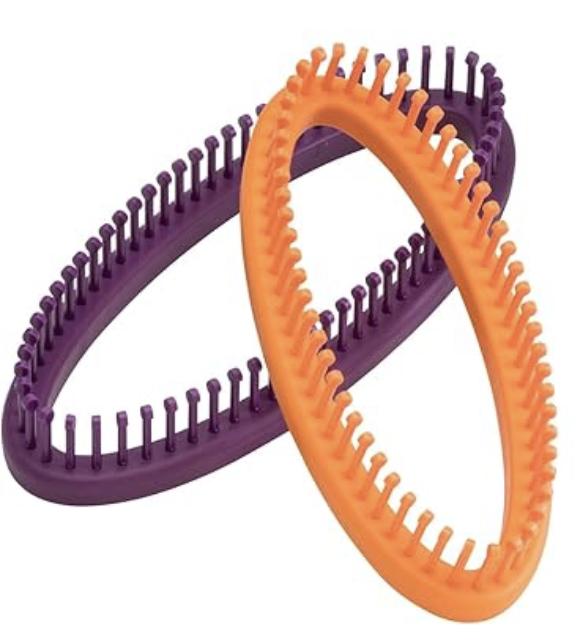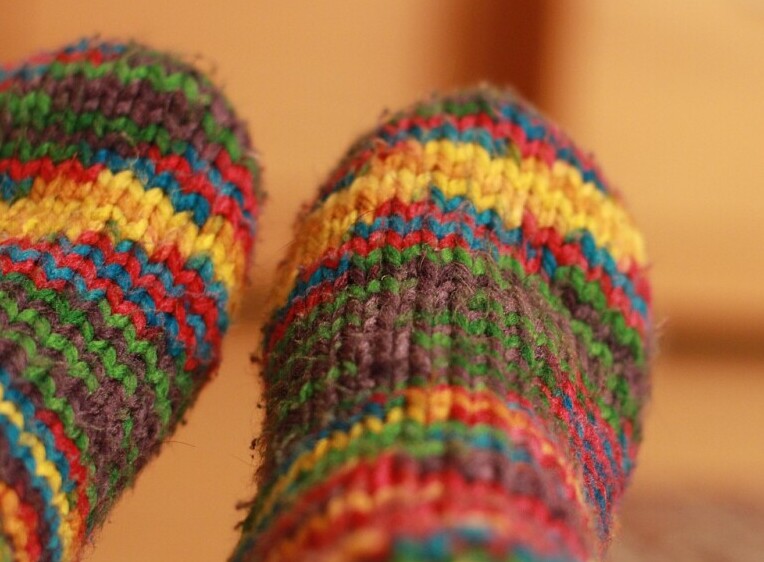I recently bought a sock loom, as I have always wanted to try a loom to knit a pair of socks. Now I need to learn how to knit socks on a sock loom. As a knitter, it seems easier to knit socks on circular needles, but let’s try something new!
Sitting down with a new sock loom can be a bit like staring at a puzzle with all the pieces scattered in front of you. The exciting part is, once you know what you’re looking at, things start to make sense pretty quickly.
A sock loom is your best bud for crafting beautifully snug hand-made socks. It’s essentially a small, circular or rectangular frame with evenly spaced pegs — like a miniature horse race track for yarn. They come in various sizes, typically to accommodate different yarn weights and foot sizes, making them a versatile tool for any aspiring knitter. A sock loom is also great if you don’t know how to knit, as they are easy to learn to use.
There’s a bunch of sock looms out there from different brands and styles, but don’t let that overwhelm you. Each has its own perks. For instance, adjustable sock looms can be a game-changer, letting you tweak the size as you go, while fixed ones are usually durable and great for keeping those efforts consistent. So, choosing the right loom aligns with what socks you’re going after — whether it’s baby booties or adult-sized snuggly wonders.
This post may contain affiliate links, which means the owner of this website may get qualifying commissions, at no extra cost to the buyer.
 How To Knit Socks On A Sock Loom
How To Knit Socks On A Sock Loom
Before jumping into knitting your first sock, you’ll need a few essentials besides your loom. Picking yarn is a vital step, and it’s all about finding something stretchy yet durable. Wool blends are popular because they mix warmth and elasticity, perfect for socks. A crochet hook or a knitting tool will be your go-to gadget for adjusting and securing stitches as you make progress. Of course, a yarn needle and scissors will help finish things up or correct any hiccups along the way.
Knowing the lingo in knitting is like having a guidebook to a new city. Terms like ‘gauge’ — the measure of stitch density, ‘rows’, and ’rounds’ are your coordinates for navigating patterns. These will help you gauge (see what I did there?) everything from the fit of your sock to how to follow patterns just right.
Before you dive into knotting and looping, setting your loom up the right way is crucial. Adjusting it for the yarn weight and sock size means the difference between comfy wearables and, well, something better fitted for a lost and found. So take a moment to align everything, and you’ll be setting yourself up for glorious success from the start.
I love this His and Hers Sock Loom, as it allows you to knit in many different sizes.
 The package includes two socks looms, 56 and 64 pegs, knitting loom hook/tool, and how-to instructions for beginner loom knitting.
The package includes two socks looms, 56 and 64 pegs, knitting loom hook/tool, and how-to instructions for beginner loom knitting.
Crafting Your First Sock
Tackling that first stitch on your sock loom can feel daunting, but casting on is your ticket to sock-making adventure. Start by securing your yarn to the anchor peg, then wrap each loom peg to create your foundation stitches. This step is a biggie, so take it slow and make sure your loops are even and not too tight. Good foundations set the stage for awesome socks.
Once your base is good to go, you’ll get into the groove of knitting the cuff ribbing. This part adds elasticity to the top of your sock, keeping it up where it should be. Using the knit-purl technique, you’ll go back and forth between pegs to build that stretchy ribbed design. It’s all about keeping a relaxed tension — nothing’s worse than a sock that squeezes your calf like a boa constrictor.
With a solid cuff in place, the next move is knitting the leg of your sock. Now, it might sound fancy, but it’s just about building rows evenly on the loom. Keep an eye on your progress, and maintain that even tension we talked about earlier. This is where the sock really starts taking shape, so enjoy the process and watch it grow round after round.
Turning the heel might sound like magic, but really, it’s just knowing your way around a few stitches. This section involves working rows back and forth in a technique known as short-row knitting. Basically, you’ll be focusing on part of the loom to create a little pocket for your heel. Pay close attention to those stitches — they’re what give your sock that snug fit around the heel.
Now that you’re over the heel hump, it’s time to craft the foot. Remember to measure as you go, making sure there’s enough room as you move toward the toes. You want your sock to fit cozily, not like it’s cramping your style — or your toes.
Once the foot is just right, you’ll finish off with the toe section, shaping it carefully so there’s no leftover bulk. This part of the sock narrows down, bringing things to a neat close. Use a seamless bind-off technique to give the toe a nice, smooth finish, because nobody digs seams rubbing against their toes! With that, you’ve knitted a sock! Time to celebrate those newfound skills!
Here is a video with step by step instructions on how to knit socks on a sock loom. It uses the loom advertised above.
If you are wanting some more great sock ideas, try this book called Loom Sock Projects. It is great for beginners and includes mittens, gloves and leg warmers too!
Common Mistakes and Troubleshooting Tips
Knitting socks on a loom can be super rewarding, but the journey isn’t always smooth-sailing. Tight stitches are a common hiccup that can challenge any newbie. If you find your loops on the pegs getting too tight, your yarn might be stretched too snugly. Loosen your grip a bit and wrap the yarn gently around the pegs. Consistent tension is the goal, and it might take a bit of practice, but hang in there.
Missed stitches happen to the best of us, especially when you’re new to the rhythm of the loom. Keeping track of each peg can be a task, but try to scan your loom from time to time to spot any missed links. If you catch a missed stitch, loop it back onto the peg and knit over it in the next row. Better to fix it early on than when you’re ten rows deep!
Dropped stitches are like little knitting landmines. But no worries, they’re totally fixable! If you spot one, use a crochet hook or knitting tool to pull the dropped stitch back over the peg. Secure it with the current row and continue like nothing happened. It’s all part of the learning curve, and even seasoned knitters drop stitches from time to time.
Learning to read your knitting might sound like reading a book in a new language, but it’s vital for troubleshooting. As you knit, keep an eye out for how your fabric looks and feels. Are the stitches even? Is the pattern consistent? Picking up on these cues early helps you avoid bigger issues down the line.
Pro tips from seasoned knitters can make all the difference. One trick is to knit a small swatch or test piece before diving into a full sock. This little preview helps you fine-tune tension and gauge. Also, don’t be afraid to mix different yarn types or weights once you’re comfortable, experimenting is part of honing your craft. Above all, patience and practice are your best tools for any knitting woes you might encounter.
Please comment below if you have any other tips for beginners on how to knit socks on a sock loom.

What a delightful and thorough guide! I love how it breaks down sock‑loom knitting step by step—from choosing the perfect yarn and loom, to shaping heels and toes with confidence. The free patterns and clever tips make it so accessible, even for total beginners. I’m now inspired to cozy up and cast on my first pair. Thanks for turning a once‑intimidating craft into something truly achievable and fun!
Hey Michel,
I actually started using a sock loom last winter and it changed how I feel about knitting socks as it’s so much more approachable than I expected! This article lays out the process really clearly, and I wish I had read something like this when I first started. It’s a very satisfying project once you get the hang of the tension. Have you found any particular yarn types that work best with looms for a cozy but durable finish?
Take care,
Marlinda
I love using thick 4 ply yarns or even thicker for the chunky look, but if you are looking for easier, thin wool is easier to knit with, especially when starting out.